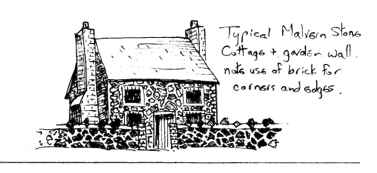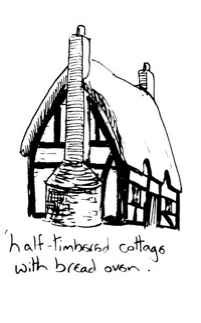THE BCH ARCHIVE
LOCAL HISTORY FOR
BIRTSMORTON
CASTLEMORTON
HOLLYBUSH
And The Surrounding District
CASTLEMORTON COMMON GUIDEBOOK
4. Building styles and materials.
4 BUILDING STYLES AND MATERIALS
There are buildings on, and around, the common, which
date from the l5th Century to the present, and which
represent all the different architectural periods.
The obvious styles, eg ‘Georgian’, can be seen, but
many of them, particularly the bigger houses, are in
fact a hotch-potch of improvement and addition, so that
one house may have parts dating from 1450, and others
from Victorian times.
It is probably better to concentrate on the materials
used in the buildings, and how these reflect the
influence of the landscape.
Malvern stone is a poor building material, very heavy,
and, being igneous, has no good bedding or jointing
planes - in other words it is impossible to carve, and
the pieces very rarely have two faces at right angles.
Walls are usually built of two sections using any flat
faces on the outside with a rubble and lime-and-marl
mortar filling. Where two rightangled faces are
needed, for instance on corners or around doorways and
windows, bricks, timber, or some imported carveable
stone had to be ued. (Welland church is a very good
example of this style).
However. many of the old farm houses and outbuildings
near the hills were buil* ~_ this clumsy material,
simply because it was so near and therefore convenient,
but it is noticeable that the use of the stone, very
prevalent in buildings close to the hills, dies out
completely in less than a mile away from them.
Lower down the common, especially in the valleys, there are some very good examples of wattle-and-daub (locally
called wattle-and-dab). Hove, although there is no
good building stone to hand there was plenty of big
Chase timber, elm and oak, for the main construction of
the houses, with plenty of hazel and black poplar for
the wattle (basket work) infill between the main
Limhnrs, and the clay, or daub, with which to plaster
the wattle panels. The timbers were painted with tar-
Lype mixture, to keep out the wood-boring insects, and
the daub was covered in a mixture or whitening and
tallow, which made it waterproof, so that the clay
wnuld not be easily washed away. Add to this the use
of Lhatch, because ihufé was no suitable material for
roof-tiles, and you have the typical black and white
‘half timbered' style of architecture, which is found
ull across the Severn Valley as far as the Cotswolds.
In the south eastern part of the common there are a few
huildings eg the'outbuildings at Biddles Farm, just
south of the Robin Hood, which are made of a greyish
sandstone, where a few narrow outcrops of this occur.
It is sometimes called the Arden sandstone, and being a
sedimentary rock, it will split into fairly good
rectangular pieces. On the hill at Coombe Green
rommon, above the Post QffiC&, there are many
depressions, locally called the Foxholes, which are the
remains of the quarries from which Iron Age man dug the
Arden sandstone in order to build the strong dry-stone
walls of the fort on Midsummer Hill.
Many red-brick farmhouses, with white sills and
surrounds to the windows, date from the Georgian period
and later. when new buildings sprang up with the
enclosures mentioned in an earlier section. Since
Victorian Limes, it has been possible to import
materials from outside the area, so that now there are even some buildings which incorporate Cotswold stone!
However, the houses around the common generally
maintain the mixture of Malvern stone and half-
timbering, a good example of vernacular styles.



By Med Snookes
A handbook for Locals and Visitors
